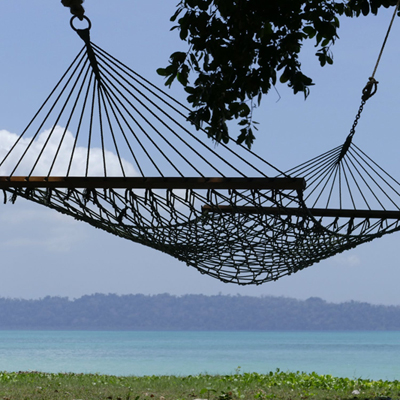Angola Country Facts

Official Name: Republic of Angola
Alternate Names: Angola, Republica de Angola
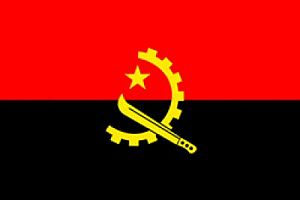 Former Names: People's Republic of Angola
Former Names: People's Republic of Angola
Capital City: Luanda
Flag: The flag has two equal horizontal bands of red and black with a centered yellow emblem consisting of a five-pointed star within half a cogwheel crossed by a machete.
Date of Independence: November 11, 1975
National Anthem: "Angola Avante" (Forward Angola)
Population: 12,799,293
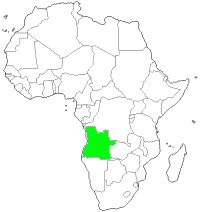 Size/Area: 1,246,700 sq km, slightly less than twice the size of Texas.
Size/Area: 1,246,700 sq km, slightly less than twice the size of Texas.
Land Locked: No
Coastline: 1600 km
Bordering Countries: Democratic Republic of the Congo, Republic of the Congo, Namibia, Zambia
Administrative Divisions: 18 provinces - Bengo, Benguela, Bie, Cabinda, Cuando Cubango, Cuanza Norte, Cuanza Sul, Cunene, Huambo, Huila, Luanda, Lunda Norte, Lunda Sul, Malanje, Moxico, Namibe, Uige, Zaire
Major Cities: Benguela, Huambo, Lobito, Namibe
Languages: Portuguese (official), Bantu and other African languages
Religions: indigenous beliefs, Roman Catholic, Protestant
Major Holidays: New Year's Day, Martyrs of the Colonial Repression Day (Jan 4), Start of Liberation War (Feb 4), International Women's Day (Mar 8), Peace and Reconciliation Day (Apr 4), Good Friday, Easter Monday, Labour Day (May 1), Africa Day (May 25), International Children's Day (June 1), Nation's Founder and National Heroes Day (Sept 17), All Soul's Day (Nov 1), Independence Day (Nov 11), Christmas Day.
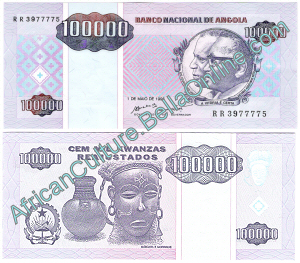 Currency: Angolan Kwanza
Currency: Angolan Kwanza
Currency Code: AOA
Highest Point: Morro de Moco 2,620 m
Lowest Point: Atlantic Ocean
Bordering Bodies of Water: Atlantic Ocean
Climate: Angola is semiarid in the south and along the coast. The north has a cool, dry season from May to October and a hot, rainy season from November to April.
Major Industries: petroleum; diamonds, iron ore, phosphates, feldspar, bauxite, uranium, and gold; cement; basic metal products; fish processing; food processing, brewing, tobacco products, sugar; textiles; ship repair
Major Agricultural Products: bananas, sugarcane, coffee, sisal, corn, cotton, manioc (tapioca), tobacco, vegetables, plantains; livestock; forest products; fish
Natural Resources: Petroleum, diamonds, iron ore, phosphates, copper, feldspar, gold, bauxite, uranium
Time Zone: UTC +1
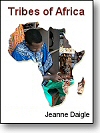 Tribes of Africa eBook
Tribes of Africa eBook
This eBook is the most complete listing of African tribes available on the internet. The first section of this book is the tribes sorted alphabetically by country. The second section is the tribes sorted alphabetically by tribe name.
Alternate Names: Angola, Republica de Angola
 Former Names: People's Republic of Angola
Former Names: People's Republic of AngolaCapital City: Luanda
Flag: The flag has two equal horizontal bands of red and black with a centered yellow emblem consisting of a five-pointed star within half a cogwheel crossed by a machete.
Date of Independence: November 11, 1975
National Anthem: "Angola Avante" (Forward Angola)
Population: 12,799,293
 Size/Area: 1,246,700 sq km, slightly less than twice the size of Texas.
Size/Area: 1,246,700 sq km, slightly less than twice the size of Texas.Land Locked: No
Coastline: 1600 km
Bordering Countries: Democratic Republic of the Congo, Republic of the Congo, Namibia, Zambia
Administrative Divisions: 18 provinces - Bengo, Benguela, Bie, Cabinda, Cuando Cubango, Cuanza Norte, Cuanza Sul, Cunene, Huambo, Huila, Luanda, Lunda Norte, Lunda Sul, Malanje, Moxico, Namibe, Uige, Zaire
Major Cities: Benguela, Huambo, Lobito, Namibe
Languages: Portuguese (official), Bantu and other African languages
Religions: indigenous beliefs, Roman Catholic, Protestant
Major Holidays: New Year's Day, Martyrs of the Colonial Repression Day (Jan 4), Start of Liberation War (Feb 4), International Women's Day (Mar 8), Peace and Reconciliation Day (Apr 4), Good Friday, Easter Monday, Labour Day (May 1), Africa Day (May 25), International Children's Day (June 1), Nation's Founder and National Heroes Day (Sept 17), All Soul's Day (Nov 1), Independence Day (Nov 11), Christmas Day.
 Currency: Angolan Kwanza
Currency: Angolan KwanzaCurrency Code: AOA
Highest Point: Morro de Moco 2,620 m
Lowest Point: Atlantic Ocean
Bordering Bodies of Water: Atlantic Ocean
Climate: Angola is semiarid in the south and along the coast. The north has a cool, dry season from May to October and a hot, rainy season from November to April.
Major Industries: petroleum; diamonds, iron ore, phosphates, feldspar, bauxite, uranium, and gold; cement; basic metal products; fish processing; food processing, brewing, tobacco products, sugar; textiles; ship repair
Major Agricultural Products: bananas, sugarcane, coffee, sisal, corn, cotton, manioc (tapioca), tobacco, vegetables, plantains; livestock; forest products; fish
Natural Resources: Petroleum, diamonds, iron ore, phosphates, copper, feldspar, gold, bauxite, uranium
Time Zone: UTC +1
 Tribes of Africa eBook
Tribes of Africa eBookThis eBook is the most complete listing of African tribes available on the internet. The first section of this book is the tribes sorted alphabetically by country. The second section is the tribes sorted alphabetically by tribe name.
This site needs an editor - click to learn more!
You Should Also Read:
South Africa Country Facts
Zambia Country Facts
Zimbabwe Country Facts
Related Articles
Editor's Picks Articles
Top Ten Articles
Previous Features
Site Map
Content copyright © 2023 by Jeanne Egbosiuba Ukwendu. All rights reserved.
This content was written by Jeanne Egbosiuba Ukwendu. If you wish to use this content in any manner, you need written permission. Contact
BellaOnline Administration
for details.


